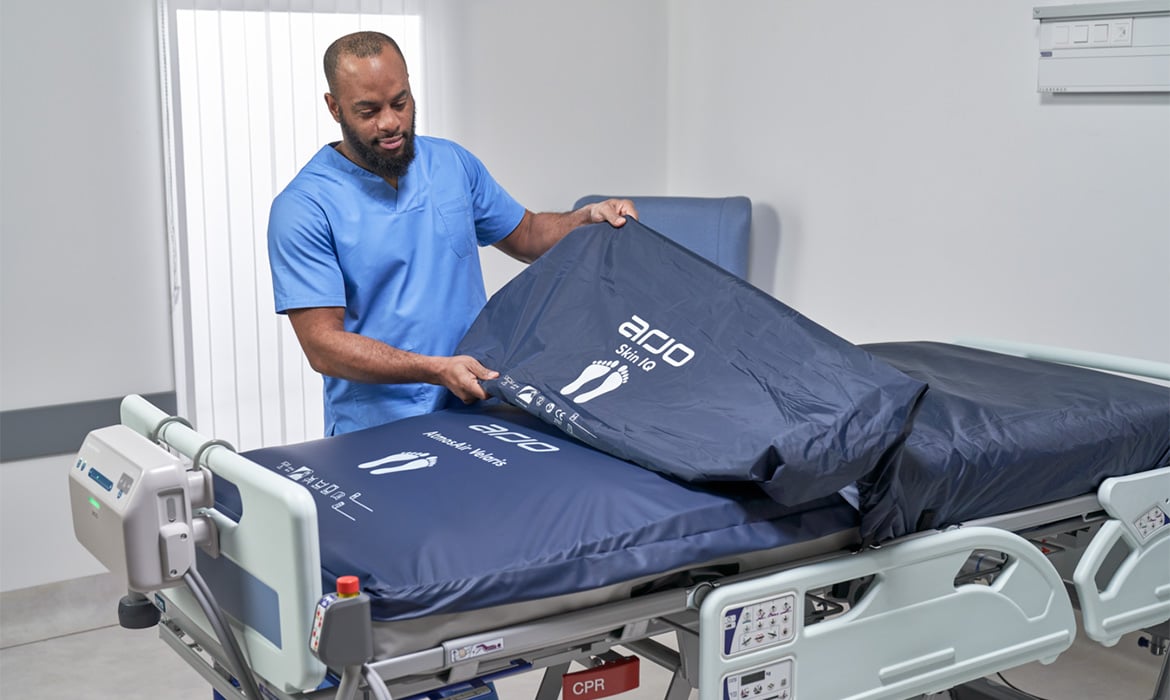The “Humiditure” is Rising: Dealing with Microclimate in pressure injury prevention
Author: Carroll Gillespie, RN, CWOCN, Clinical Solutions Manager
Like most of the United States, it seems that summer came early and with a vengeance. All states are experiencing excessively high temperatures, and the humidity has been extremely high. In my hometown of Jacksonville, the weather correspondents refer to the “humiditure”, what the air feels like with the high temperature and humidity combined.

Challenges of Microclimate
Even though the air in a hospital, nursing home or LTAC is well controlled, many patients and residents who are in bed or in a bedside chair designed to be fluid resistant experience issues with microclimate. The National Pressure Injury Advisory Panel (NPIAP) Support Surface Standardization (S3I) committee has defined microclimate as “temperature and humidity in a specified location. For purposes of support surfaces, microclimate refers to temperature and humidity at the support surface/body interface.”1 The surface can be the facility mattress, chair or stretcher.
"Microclimate refers to temperature and humidity at the support surface/body interface."
I personally was hospitalized a few months ago for 5 nights. I had the air conditioner turned down as low as it could go and was still “sweaty” from lying on the bed. Even though I was ambulatory and able to reposition myself, about 2 ½ days into my stay I had immense itching on my middle and lower back. I had the nurse look at it and it was determined I had a heat rash, with raised red “bumps”. It required an antihistamine capsule as well as frequent linen changes.
"I had a microclimate issue, which can make my skin more susceptible to pressure injuries."
I had a microclimate issue, which can make my skin more susceptible to pressure injuries. Luckily, since I could turn myself to relieve the pressure, I was able to mitigate that contributing factor. However, I could have benefited from microclimate management!
Managing Microclimate for pressure injury prevention
There are several key methods for decreasing the microclimate. Caregivers are familiar with the idea of positive air flow technology, or low air loss, where air is circulated beneath a water vapor permeable cover to control the humidity under the patient.2 The air either escapes from the mattress itself or from a tubing that runs around the perimeter of a surface or on the base of the surface. An additional way to decrease microclimate is by turning and repositioning a patient so that ambient room air can circulate around the previous part of the body that was in contact with the support surface, the final way is through “negative air flow” technology. Arjo has a unique product called the Skin IQ®, which is a microclimate coverlet that goes directly onto a support surface. Skin IQ allows excess moisture to pass through the vapor-permeable, antimicrobial top layer and into the middle layer spacer material via an evaporative effect. The top layer also serves as a barrier to fluid and bacteria. The evaporative capacity of Skin IQ 365 is 230 (g/m2/hr).3
Skin IQ coverlet, a game changer in Microclimate management
The Skin IQ has been tested on multiple Arjo as well as competitive products. S3I testing for immersion and envelopment demonstrates that the addition of Skin IQ to tested support surfaces had a negligible effect on the immersion and envelopment, but substantially increased the microclimate management properties of the surfaces. These results were exhibited at the 2023 NPIAP conference in poster format. For more information on the results, click here for What’s under the sheets matters. See all the solutions that Arjo has for pressure injury prevention and microclimate management.
Looking back, I needed to have a Skin IQ on my hospital mattress which could have prevented my heat rash and 3 days of around the clock antihistamine.
Sign up for our pressure injury prevention newsletter
To receive updates on clinical evidence, case studies, webinars by industry thought leaders and more supporting pressure injury prevention across all care settings.
References:
- https://cdn.ymaws.com/npiap.com/resource/resmgr/s3i/1023_Terms_and_Defs_2019_We.pdf accessed 06/23/24
- European Pressure Ulcer Advisory Panel, National Pressure Injury Advisory Panel, Pan Pacific Pressure Injury Alliance. Prevention and Treatment of Pressure Ulcers/Injuries: The International Guideline 2019. Emily Haesler (Ed.). EPUAP/NPIAP/PPIA:2019
- Arjo data on file